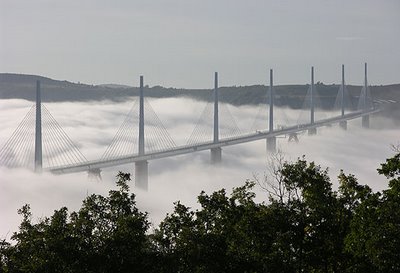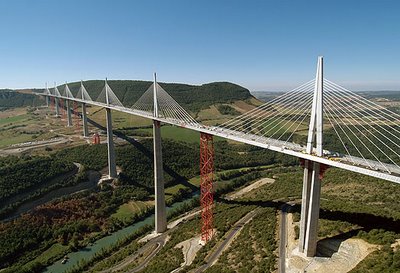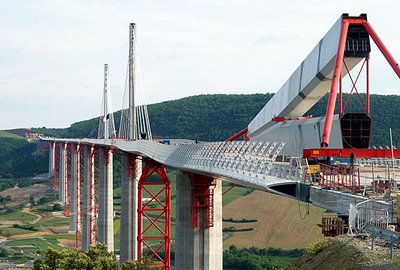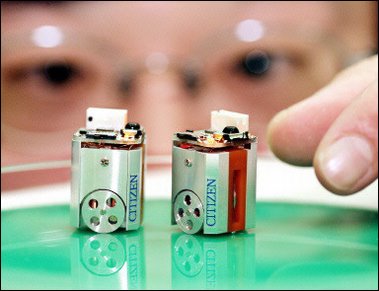Sunday, April 16, 2006
HPI Help Point Intercom for the New York City Subway

Commissioned by the Metropolitan Transit Authority, this intercom would provide information and assistance to lost tourists and commuters during emergencies, along with immediate 24/7 access to emergency personnel. Blue lights would help in a blackout and guide commuters to the intercoms where they could page for help.
Designers: Masamichi Udagawa and Sigi Moeslinger of Antenna Design (USA)
Metropolitan Transportation Authority New York City Transit company design (USA)
Manufacturer: Siemens Transportation Systems, USA (2005)
Design-Global Village Shelter


The shelters can be assembled in 15 minutes and last up to one year. They can be locked from within and stacked to form larger structures, like emergency clinics or bathrooms.
These wind- and fire-resistant folding houses were designed to provide shelter to victims and relief workers in disaster zones and were used in the reconstruction of Grenada following Hurricane Ivan in 2004.
Designer: Daniel and Mia Ferrara of Ferrara Design (USA)
Manufacturers: Global Village Shelters, LLC (USA), in partnership with Weyerhaeuser (USA)
Design-Ski Dubai

F + A Architects
When one thinks of a vacation in Dubai, the first images that might to come to mind are sun and sand. Now add snow. Two feet of snow, topped with a daily layer of fresh powder, to be exact -- thanks to the system of 23 blast coolers and snow guns inside Ski Dubai. It might be 135 degrees Fahrenheit outdoors, but inside the 32,290 square-foot, $275 million structure, visitors ski and snowboard. The heavily insulated facility also includes the world's largest indoor snow park, offering 9,842 square feet for sledding or bobsledding.
Design-Breaking the Mold

Rapid Prototyping
The lamp, inspired by a hand muff, was first produced in a limited edition using stereolithography.

Using unconventional thinking and smart design processes, Arik Levy transforms everyday household objects into beautiful works of art.
Manufactured and distributed by Materialise, this bowl is made of epoxy resin using stereolithographic 3-D printing. "The final form is a contrast between hard and soft," says Levy, who made the honeycomb pattern slightly irregular to give the sensation of a living biological material. "If you put an orange in the bowl, you have the feeling the bowl is going to eat it."
....
Google Map

www.housingmaps.com
One of the most useful mash-ups, 3D software engineer Paul Rademacher's creation was born of frustration. He needed to find a house in Silicon Valley for his job at DreamWorks Animation and grew weary of the piles of Google maps for each and every house he wanted to see. So he created a Web site that mashes up listings from the online classified-ad service Craigslist with Google's mapping service. Choose a city and a price range, and up pops a map with pushpins showing the location of each rental.
"I wanted this to be a real application, not just a Web page," says Rademacher. "The key will be what's useful, not just what's cool." His site has spurred a rash of Google Maps mash-ups, including some of the following slides.
LEE
朝花夕落,笑靨幾何?逝水無聲,歲月飛梭。
不快樂白不快樂。
__________________<<殺悶思維>>草稿
//把人生哲理說得頭頭是道的,卻每每跨不過他們心中的一道牆//
跨不過心中一道牆的人,真能把人生哲理說得「頭頭是道」乎?
大智一指,即破其頭^^
不希望您以為那算是一首詩
但那是好很精練的一篇短文
故預述<<殺悶思維>>的幾句
為贈:
_______________1_____________
情至深者可以至辣,當那是唯一選擇。
_______________2_____________
至辣無恨。
_______________3_____________
割斷過去,永不回顧,情滅、恩盡、義絕,直到永遠;
辣之至也。
_______________4_____________
無論割斷什麼,都有可能是一種解脫。
圖文俱美
伉儷亦然
不快樂白不快樂。
__________________<<殺悶思維>>草稿
//把人生哲理說得頭頭是道的,卻每每跨不過他們心中的一道牆//
跨不過心中一道牆的人,真能把人生哲理說得「頭頭是道」乎?
大智一指,即破其頭^^
不希望您以為那算是一首詩
但那是好很精練的一篇短文
故預述<<殺悶思維>>的幾句
為贈:
_______________1_____________
情至深者可以至辣,當那是唯一選擇。
_______________2_____________
至辣無恨。
_______________3_____________
割斷過去,永不回顧,情滅、恩盡、義絕,直到永遠;
辣之至也。
_______________4_____________
無論割斷什麼,都有可能是一種解脫。
圖文俱美
伉儷亦然
How I Work: Bill Gates
Bill Gates, chairman and chief software architect, Microsoft, U.S.A.
April 7, 2006: 5:17 PM EDT
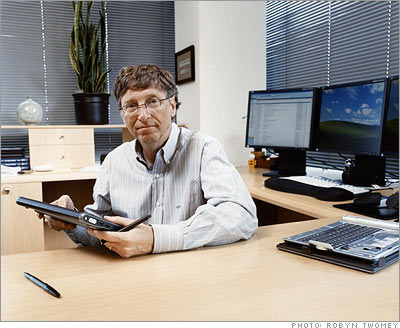
On my desk I have three screens, synchronized to form a single desktop. I can drag items from one screen to the next. Once you have that large display area, you'll never go back, because it has a direct impact on productivity.
The screen on the left has my list of e-mails. On the center screen is usually the specific e-mail I'm reading and responding to. And my browser is on the right-hand screen. This setup gives me the ability to glance and see what new has come in while I'm working on something, and to bring up a link that's related to an e-mail and look at it while the e-mail is still in front of me.
At Microsoft, e-mail is the medium of choice, more than phone calls, documents, blogs, bulletin boards, or even meetings (voicemails and faxes are actually integrated into our e-mail in-boxes).
I get about 100 e-mails a day. We apply filtering to keep it to that level-mail comes straight to me from anyone I've ever corresponded with, anyone from Microsoft, Intel, HP, and all the other partner companies, and anyone I know. And I always see a write-up from my assistant of any other e-mail, from companies that aren't on my permission list or individuals I don't know. That way I know what people are praising us for, what they are complaining about, and what they are asking.
We're at the point now where the challenge isn't how to communicate effectively with e-mail, it's ensuring that you spend your time on the e-mail that matters most. I use tools like "in-box rules" and search folders to mark and group messages based on their content and importance.
I'm not big on to-do lists. Instead, I use e-mail and desktop folders and my online calendar. So when I walk up to my desk, I can focus on the e-mails I've flagged and check the folders that are monitoring particular projects and particular blogs.
Outlook also has a little notification box that comes up in the lower right whenever a new e-mail comes in. We call it the toast. I'm very disciplined about ignoring that unless I see that it's a high-priority topic.
Staying focused is one issue; that's the problem of information overload. The other problem is information underload. Being flooded with information doesn't mean we have the right information or that we're in touch with the right people.
I deal with this by using SharePoint, a tool that creates websites for collaboration on specific projects. These sites contain plans, schedules, discussion boards, and other information, and they can be created by just about anyone in the company with a couple of clicks.
Right now, I'm getting ready for Think Week. In May, I'll go off for a week and read 100 or more papers from Microsoft employees that examine issues related to the company and the future of technology. I've been doing this for over 12 years. It used to be an all-paper process in which I was the only one doing the reading and commenting. Today the whole process is digital and open to the entire company.
I'm now far more efficient in picking the right papers to read, and I can add electronic comments that everyone sees in real time.
Microsoft has more than 50,000 people, so when I'm thinking, "Hey, what's the future of the online payment system?" or "What's a great way to keep track of your memories of your kid?" or any neat new thing, I write it down. Then people can see it and say, "No, you're wrong" or "Did you know about this work being done at such-and-such a place?"
SharePoint puts me in touch with lots of people deep in the organization. It's like having a super-website that lets many people edit and discussar more than the standard practice of sending e-mails with enclosures. And it notifies you if anything comes up in an area you're interested in.
Another digital tool that has had a big effect on my productivity is desktop search. It has transformed the way I access information on my PC, on servers, and on the Internet. With larger hard drives and increasing bandwidth, I now have gigabytes of information on my PC and servers in the form of e-mails, documents, media files, contact databases, and so on.
Instead of having to navigate through folders to find that one document where I think a piece of information might be, I simply type search terms into a toolbar and all the e-mails and documents that contain that information are at my fingertips. The same goes for phone numbers and email addresses.
Paper is no longer a big part of my day. I get 90% of my news online, and when I go to a meeting and want to jot things down, I bring my Tablet PC. It's fully synchronized with my office machine so I have all the files I need. It also has a note-taking piece of software called OneNote, so all my notes are in digital form.
The one low-tech piece of equipment still in my office is my whiteboard. I always have nice color pens, and it's great for brainstorming when I'm with other people, and even sometimes by myself.
The whiteboards in some Microsoft offices have the ability to capture an image and send it up to the computer, almost like a huge Tablet PC. I don't have that right now, but probably I'll get a digital whiteboard in the next year. Today, if there's something up there that's brilliant, I just get out my pen and my Tablet PC and recreate it.
Days are often filled with meetings. It's a nice luxury to get some time to go write up my thoughts or follow up on meetings during the day. But sometimes that doesn't happen. So then it's great after the kids go to bed to be able to just sit at home and go through whatever e-mail I didn't get to. If the entire week is very busy, it's the weekend when I'll send the long, thoughtful pieces of e-mail. When people come in Monday morning, they'll see that I've been quite busy?they'll have a lot of e-mail.
April 7, 2006: 5:17 PM EDT

On my desk I have three screens, synchronized to form a single desktop. I can drag items from one screen to the next. Once you have that large display area, you'll never go back, because it has a direct impact on productivity.
The screen on the left has my list of e-mails. On the center screen is usually the specific e-mail I'm reading and responding to. And my browser is on the right-hand screen. This setup gives me the ability to glance and see what new has come in while I'm working on something, and to bring up a link that's related to an e-mail and look at it while the e-mail is still in front of me.
At Microsoft, e-mail is the medium of choice, more than phone calls, documents, blogs, bulletin boards, or even meetings (voicemails and faxes are actually integrated into our e-mail in-boxes).
I get about 100 e-mails a day. We apply filtering to keep it to that level-mail comes straight to me from anyone I've ever corresponded with, anyone from Microsoft, Intel, HP, and all the other partner companies, and anyone I know. And I always see a write-up from my assistant of any other e-mail, from companies that aren't on my permission list or individuals I don't know. That way I know what people are praising us for, what they are complaining about, and what they are asking.
We're at the point now where the challenge isn't how to communicate effectively with e-mail, it's ensuring that you spend your time on the e-mail that matters most. I use tools like "in-box rules" and search folders to mark and group messages based on their content and importance.
I'm not big on to-do lists. Instead, I use e-mail and desktop folders and my online calendar. So when I walk up to my desk, I can focus on the e-mails I've flagged and check the folders that are monitoring particular projects and particular blogs.
Outlook also has a little notification box that comes up in the lower right whenever a new e-mail comes in. We call it the toast. I'm very disciplined about ignoring that unless I see that it's a high-priority topic.
Staying focused is one issue; that's the problem of information overload. The other problem is information underload. Being flooded with information doesn't mean we have the right information or that we're in touch with the right people.
I deal with this by using SharePoint, a tool that creates websites for collaboration on specific projects. These sites contain plans, schedules, discussion boards, and other information, and they can be created by just about anyone in the company with a couple of clicks.
Right now, I'm getting ready for Think Week. In May, I'll go off for a week and read 100 or more papers from Microsoft employees that examine issues related to the company and the future of technology. I've been doing this for over 12 years. It used to be an all-paper process in which I was the only one doing the reading and commenting. Today the whole process is digital and open to the entire company.
I'm now far more efficient in picking the right papers to read, and I can add electronic comments that everyone sees in real time.
Microsoft has more than 50,000 people, so when I'm thinking, "Hey, what's the future of the online payment system?" or "What's a great way to keep track of your memories of your kid?" or any neat new thing, I write it down. Then people can see it and say, "No, you're wrong" or "Did you know about this work being done at such-and-such a place?"
SharePoint puts me in touch with lots of people deep in the organization. It's like having a super-website that lets many people edit and discussar more than the standard practice of sending e-mails with enclosures. And it notifies you if anything comes up in an area you're interested in.
Another digital tool that has had a big effect on my productivity is desktop search. It has transformed the way I access information on my PC, on servers, and on the Internet. With larger hard drives and increasing bandwidth, I now have gigabytes of information on my PC and servers in the form of e-mails, documents, media files, contact databases, and so on.
Instead of having to navigate through folders to find that one document where I think a piece of information might be, I simply type search terms into a toolbar and all the e-mails and documents that contain that information are at my fingertips. The same goes for phone numbers and email addresses.
Paper is no longer a big part of my day. I get 90% of my news online, and when I go to a meeting and want to jot things down, I bring my Tablet PC. It's fully synchronized with my office machine so I have all the files I need. It also has a note-taking piece of software called OneNote, so all my notes are in digital form.
The one low-tech piece of equipment still in my office is my whiteboard. I always have nice color pens, and it's great for brainstorming when I'm with other people, and even sometimes by myself.
The whiteboards in some Microsoft offices have the ability to capture an image and send it up to the computer, almost like a huge Tablet PC. I don't have that right now, but probably I'll get a digital whiteboard in the next year. Today, if there's something up there that's brilliant, I just get out my pen and my Tablet PC and recreate it.
Days are often filled with meetings. It's a nice luxury to get some time to go write up my thoughts or follow up on meetings during the day. But sometimes that doesn't happen. So then it's great after the kids go to bed to be able to just sit at home and go through whatever e-mail I didn't get to. If the entire week is very busy, it's the weekend when I'll send the long, thoughtful pieces of e-mail. When people come in Monday morning, they'll see that I've been quite busy?they'll have a lot of e-mail.
